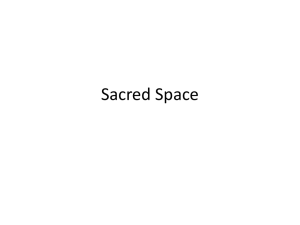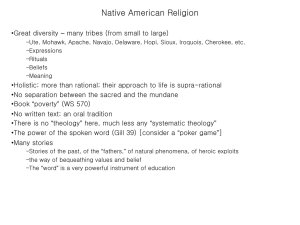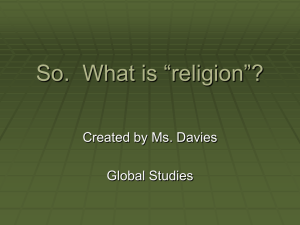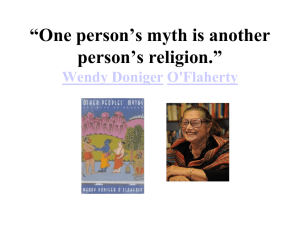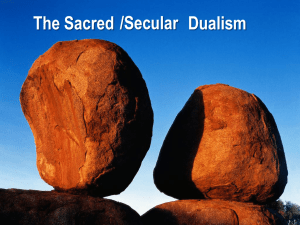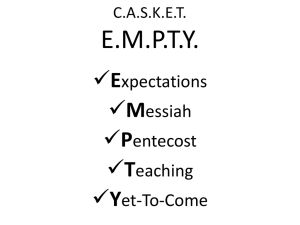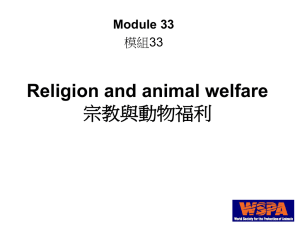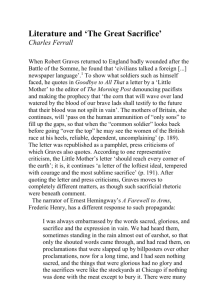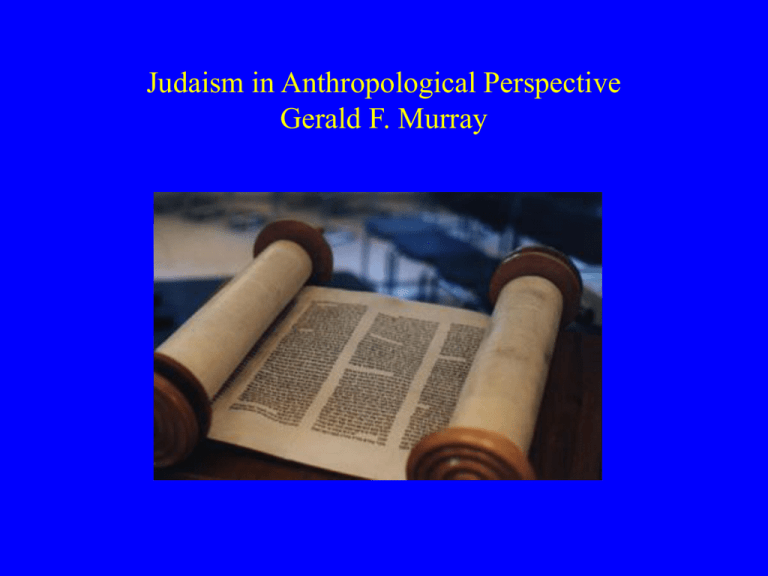
Judaism in Anthropological Perspective
Gerald F. Murray
Definition of religion
Religion is a cultural subsystem in which
humans, under the guidance of leaders with
specialized knowledge or power, engage in
ceremonial activities to contact, please,
placate, or otherwise influence one or
another invisible spirit being.
Universal structures of religion
• Invisible spirits
• Sacred behaviors – rituals / ceremonies
• Human guides and authorities
________________________________________
• Sacred words
• Sacred objects
• Sacred times
• Sacred places
The physical and temporal stage
• Traditional tribal religions have no historical “beginning”,
except perhaps for the creation of the world.
• Historical “founder” religions believe that the truth
emerged in a specific geographical place at a specific
historical time.
• The proto-preparatory event -- the call of “Abraham
avinu” – is placed in Mesopotamia some 4,000 years ago.
• The core foundational event – the giving of the Torah to
“Moshe rabbenu” – is placed on the Sinai peninsula some
3,300 years ago.
Temple Judaism and animal sacrifice
•
•
•
•
•
Animal sacrifice as a widespread pattern
From spontaneous to centralized sacrifice.
The temple as a sacred slaughterhouse
Daily sacrifices of sheep.
Why did God want animal sacrifice?
From Temple Judaism to Rabbinic Judaism
• The local synagogue in Jewish history: the house of
gathering.
• Functions of the synagogue: prayer and the reading of the
Torah
• The kohanim managed the Jerusalem Temple.
• The rabbis prevailed in the synagogue.
• The two institutions were parallel.
• With the destruction of the Temple, the synagogue and the
Rabbi became the center of Judaism
• Animal sacrifice was replaced by sacred texts and the
qiyum mitsvot, the observance of commandments.
Sacred Texts
• Not all religions have written texts.
• Judaism is based on texts, as are:
– Hinduism (the Vedas)
– Christianity (the New Testament)
– Islam (the Quran)
Sacred texts of Judaism
•
•
•
•
•
•
Torah (The 5 books. Pentateuch. Sefer Torah vs. Chumash)
Neviim (Prophets -- e.g. Isaiah, Jeremiah)
Ketuvim (Other biblical writings – e.g. Tehilim, psalms)
Talmud (Mishnah and Gemara)
Law codes (Shulchan Aruch, Mishneh Torah)
Kabbalah (Sefer hayetsirah, Zohar, Tanya)
• These are the sources to consult to find “what Judaism teaches”
• “What Jews believe” may be different. But these are the authoritative
sources
Evolution of the spirit world
• Polytheism
• Henotheism
• Monotheism
The Spirit World of Judaism
•
•
•
•
•
Hashem (the unpronounceable name)
Malachim (angels)
Shedim (demons)
HaSatan (the accuser)
The human soul
Evolving images of God
•
•
•
•
•
•
The mountain God: Sinai / Horeb
The desert God: Ark of the Covenant
The God of animal sacrifice: Beit haMikdash
God of the universe: The exiled Israelites
God the judge: the heavenly court
The impersonal God of the Kabbalah
Anthropomorphic features of the Hebrew God
• Anthropomorphic elements of the Biblical God
– Body parts, gender, sense perception, emotion
• Dwelling places of the Biblical God
– The mountain Sinai / Horeb, the desert Tabernacle, the
Jerusalem Temple
• Social roles of the Biblical God
– Warrior, King, Judge, Father, Husband
The impersonal God of the Kabbalah
• The destruction of the Temple
– threatened the concept of the localized God.
• Contact with the Greeks
– threatened belief in the anthropomorphic God
• Conceptual life-boat: allegorization
• The God of the Kabbala:
– Sefirot: Emanations and the impersonal “Ein Sof”
– Adam qadmon – retention of human body
Evolving theories of the human soul
• Universality of beliefs in the soul
• Clarifying the “afterlife” concept
• Emergence of the “differentiated” afterlife:
post-mortem reward and punishment.
Biblical images of reward and punishment
• Sheol as the place of the dead in Biblical
times.
• Material rewards for good deeds:
– Land and offspring to nomadic Abraham
– Rain, crops, livestock, food to agrarian
Israelites
• Drought, famine, enslavement, early death
as punishment for transgression
The origin of heaven and hell
• Zoroaster and the Persian connection?
• The passage in Maccabees II – praying for
the souls of the dead.
• Resurrection of dead bodies, reuniting with
souls. Techiyat hametim.
• Evidence from New Testament passages.
Rabbinic Judaism and the afterlife
• “Garden of Eden” as Heaven.
• “The Valley of Hinnom” as Purgatory.
– Gehinnom as a place of fire
– Viewed as temporary
• Ritual attention to the dead:
– The Kaddish
– The yahrtseit
– The graves of Tsadiqim
The Kabbalah and reincarnated souls
• Sources of Kabbalistic teaching
• The doctrine of gilgul neshamot, the
“recycling of souls”
• The sefirot: Emanations of God
• The damaged Universe
• The damaged soul
• The process of tiqun – repairing what is
broken.
The commandments, the healing of the world,
the healing of the soul
•
•
•
•
Time as a sacred resource
The home as a sacred place
The body as a sacred temple
The community as a holy people
Time as a sacred resource
•
•
•
•
The sacred yearly cycles
The sacred seventh day
The sacred daily prayer times
The probing of sacred texts
The home as a sacred place
•
•
•
•
•
The mezzuza on the door
The saints on the walls
The purified kitchen
The holy books
Beware of the T.V. and the internet
The body as a sacred temple
• The regulation of food
– The rules of kashrut
• Forbidden foods
• Other foods must be ritually clean
– No eating without a blessing
• The regulation of sexuality
–
–
–
–
Strict religious endogamy, rules against intermarriage
The rise of monogamy
Sex restricted to marriage
“Family purity” and the menstrual cycle
The community as a holy people
• Rules of membership
– Matrilineal descent
– The process of conversion
• Rules of conduct
– The duty of tithing and tsedaqah
– Watching one’s tongue.
– The obligation of the prayer minyan
Unresolved tensions
• External tensions
– Israel or Palestine: Jews and Muslims
– Jews and non-Jews in Western countries
• Internal tensions
– Jewish factions and “streams”
– The role of the Jewish woman
– Intermarriage and matrilineal descent




